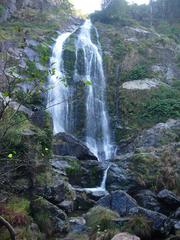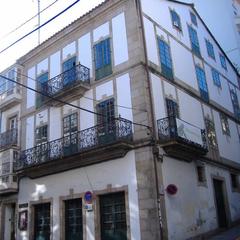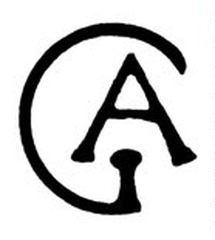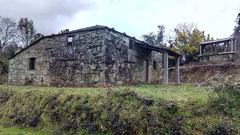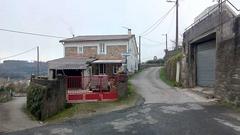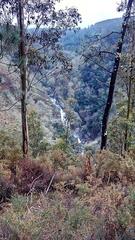Visiting Punta Penencia: Hours, Tickets, and Historical Sites in Ferrol, Spain
Date: 17/08/2024
Introduction
Punta Penencia, located in Ferrol, Spain, is a treasure trove of historical and cultural significance. This coastal gem offers a blend of rich history, stunning natural beauty, and vibrant cultural events, making it a must-visit destination for travelers. The region’s history dates back to prehistoric times, with archaeological evidence of early human settlements. Over the centuries, Punta Penencia and Ferrol have played pivotal roles in various historical events, from the Roman era to the Peninsular War. The area is also known for its maritime heritage, with Ferrol serving as a crucial naval center since the 18th century (Wikipedia, Visit Ferrol).
Visitors to Punta Penencia can explore a range of attractions, including the Castle of San Felipe, the geometrically laid-out Magdalena neighborhood, and the starting point of the English Way path of the Camino de Santiago. The region also boasts beautiful beaches like Doniños and San Xurxo, perfect for surfing and other water sports. With various cultural events, such as the Meninas de Canido street art transformation and the internationally recognized Holy Week celebrations, Punta Penencia offers a unique and immersive experience for all visitors (Love for Info, Spain Info).
Historical Background
Early History and Prehistoric Significance
The area surrounding Punta Penencia, including Ferrol, has a rich prehistoric heritage. Archaeological findings suggest the presence of early human settlements, evidenced by burial chambers, megalithic monuments, and petroglyphs. The Phoenicians and Ancient Greeks established several dried and salted cod stations in this region, as documented by classical historians like Herodotus and Strabo (Wikipedia).
Roman Era
During Roman times, the area that would become Ferrol was known for its fishing port, which also traded in metals such as silver, gold, tin, and iron. The port was a significant hub for the Artabri tribe, who dominated the region. The name “Ferrol” can be traced back to the Middle Ages, with the earliest mention in a document from 1087 referring to “sancto Iuliano de Ferrol” (Wikipedia).
Medieval Period
In the medieval period, Ferrol was granted to the powerful Andrade family by Henry II in 1371. The town’s importance grew as a royal arsenal, especially after a fire in 1568 reduced the old medieval town to rubble. This period also saw the construction of fortifications at the estuary’s entrance (Wikipedia).
The Enlightenment and Naval Significance
The arrival of the Bourbons in the 18th century marked a transformative period for Ferrol. Under the leadership of the Marquis of Ensenada, the town became a leading naval center and was made the capital of the Maritime Department of the North. Rapid improvements followed, including the construction of new fortresses and castles, such as San Carlos, making Ferrol almost unassailable from the sea (Wikipedia).
The Battle of Brion and British Invasion
In 1800, the British fleet attempted to land on Doniños beach, aiming to take Ferrol and destroy its shipyards. However, the local forces, aided by the castle of San Felipe’s defense, successfully repelled the attack, causing the British to withdraw. This event is known as the Battle of Brion (Visit Ferrol).
The Peninsular War and French Occupation
Despite an alliance with the United Kingdom during the Peninsular War (1808–1814), Ferrol’s fortunes deteriorated. The arsenals and fortresses were abandoned, leading to an easy occupation by the French in 1809. This period marked a significant decline in the town’s strategic importance (Wikipedia).
Modern Era and Naval Heritage
Ferrol has maintained its naval significance into the modern era. It has been a major naval shipbuilding center and the capital of the Spanish Navy’s Maritime Department of the North since the early Bourbons. The city is home to some of the major shipbuilding yards of the Navantia Group. Ferrol’s naval heritage is also preserved in various museums, including the shipyard museum and the naval museum (Wikipedia).
Cultural and Historical Attractions
The Castle of San Felipe
Ferrol’s historical and cultural attractions are numerous. The Castle of San Felipe, built in the 18th century, is a notable landmark and is on the nomination list to become a UNESCO World Heritage site. The castle’s strategic location on the estuary of Ferrol offers a glimpse into the town’s military past (Love for Info).
The Magdalena Neighborhood
The A Magdalena neighborhood, characterized by its geometric layout typical of the Enlightenment, is another significant historical area. It was developed by naval engineers and contributed to the city’s growth, reaching a population of 20,000 by the end of the 18th century (Visit Ferrol).
The English Way and Pilgrimage
Ferrol is one of the starting points of the English Way path of the Camino de Santiago. Modern requirements for pilgrims to travel 100 km by foot to be officially recognized make Ferrol a preferred starting point. This tradition dates back to the Middle Ages when pilgrims from northern Europe and the British Isles arrived by sea to the port of Ferrol (Wikipedia).
The Meninas de Canido
In recent years, the Canido district has undergone a transformation through street art. Local artist Eduardo Hermida initiated an artistic crusade in 2008, inspired by Velázquez’s “Meninas.” This project has turned Canido into one of the trendiest neighborhoods in Ferrol, attracting both local and international artists (Love for Info).
Holy Week Celebrations
Ferrol’s Holy Week celebrations are a major cultural event, declared of International Tourist Interest. These celebrations, with almost 500 years of history, are held in March or April, depending on when Easter falls. The event features processions, religious ceremonies, and various cultural activities (Spain Info).
Beaches and Natural Beauty
Ferrol is also known for its stunning beaches, such as Doniños, Esmelle, Fragata, and San Xurxo. These beaches are popular for surfing and other water sports. The natural beauty of the area, with its fine white sand and turquoise waters, makes it a hidden gem in Galicia (Trotando Mundos).
Visitor Information
Visiting Hours and Tickets
Visitors to Punta Penencia can explore the site daily from 9 AM to 6 PM. Tickets are available at the entrance for €5 for adults and €3 for children and seniors. Guided tours are offered on weekends and holidays.
Travel Tips and Accessibility
- Getting There: Punta Penencia is accessible by car, with parking available on-site. Public transportation options include buses from Ferrol’s city center.
- Accessibility: The site is partially accessible to visitors with mobility impairments. Wheelchair-friendly paths are available, but some areas may be challenging to navigate.
- Best Time to Visit: The best time to visit is during the spring and summer months when the weather is pleasant and outdoor activities can be enjoyed.
Special Events and Guided Tours
Punta Penencia hosts several special events throughout the year, including historical reenactments, cultural festivals, and photography workshops. Guided tours provide in-depth insights into the site’s history and significance.
FAQ
Q: What are the visiting hours for Punta Penencia? A: Punta Penencia is open daily from 9 AM to 6 PM.
Q: How much are the tickets? A: Tickets are €5 for adults and €3 for children and seniors.
Q: Are guided tours available? A: Yes, guided tours are available on weekends and holidays.
Q: Is Punta Penencia accessible for visitors with disabilities? A: The site is partially accessible, with wheelchair-friendly paths available.
Conclusion
Ferrol’s rich history, cultural heritage, and natural beauty make it a fascinating destination for tourists. Whether exploring its naval past, enjoying its beaches, or participating in its vibrant cultural events, Ferrol offers a unique and memorable experience. Don’t forget to check out other related posts and follow us on social media for more updates (Alex Getting Lost, Guías Viajar).
References
- Wikipedia. (n.d.). Ferrol, Spain. Retrieved from Wikipedia
- Visit Ferrol. (n.d.). History. Retrieved from Visit Ferrol
- Love for Info. (n.d.). Ferrol Galicia. Retrieved from Love for Info
- Spain Info. (n.d.). Ferrol. Retrieved from Spain Info
- Alex Getting Lost. (2019, April 7). Exploring the Port City of Ferrol, Spain. Retrieved from Alex Getting Lost
- Guías Viajar. (n.d.). Galicia: What to See in Ferrol. Retrieved from Guías Viajar
